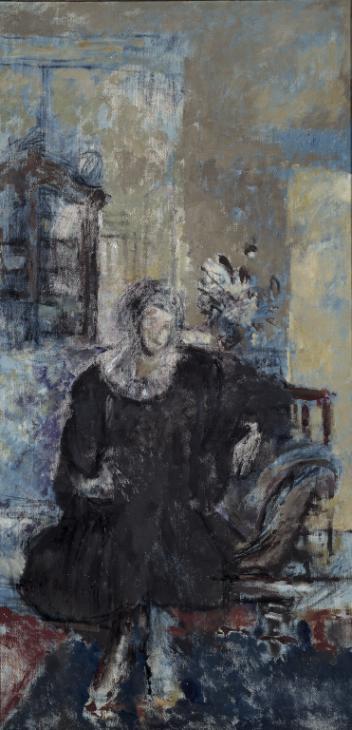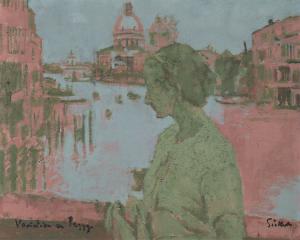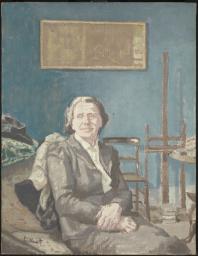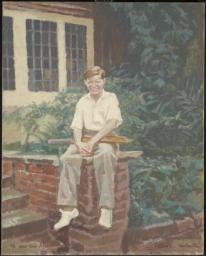Walter Richard Sickert Mrs Anna Knight 1941-2
Walter Richard Sickert,
Mrs Anna Knight
1941-2
Walter Sickert’s usual habit of painting from drawings and photographs was abandoned for a series of studies from life in the Bath home of Mrs Anna Knight. A cupboard with glass doors and vase of flowers stand behind Knight, seated on a sofa in the foreground, her long black dress mingling into the mauve and deep blue tones of the carpet. Framed by a white pie-frill collar, the features of her face have been lightly sketched in, partly in charcoal or black oil crayon. A pale pink and light blue camaieu preparation is still visible across areas of the canvas, where dull beige tones have been used to articulate the interior ceiling and background walls. Sickert eventually became too ill to continue work on the portrait and died soon after in January 1942.
Walter Richard Sickert 1860–1942
Mrs Anna Knight
1941–2
Oil paint on canvas
1524 x 762 mm
Bequeathed by Mrs Anna Knight 1953
N06142
1941–2
Oil paint on canvas
1524 x 762 mm
Bequeathed by Mrs Anna Knight 1953
N06142
Ownership history
Commissioned from the artist by Charles Neil Knight, Bath, and left unfinished with him at artist’s death 1942; bequeathed by Mrs Anna Knight to Tate Gallery 1953.
Exhibition history
1960
Summer Exhibition, Bath Academy of Art, July 1960.
1981–2
Late Sickert: Paintings 1927–1942, (Arts Council tour), Hayward Gallery, London, November 1981–January 1982, Sainsbury Centre for the Visual Arts, University of East Anglia, Norwich, March–April 1982, Wolverhampton Art Gallery, April–May 1982 (37).
1989–90
W.R. Sickert: Drawings and Paintings 1890–1942, Tate Gallery, Liverpool, March 1989–February 1990, Tate Gallery, London, July–September 1990 (41, reproduced).
References
1960
Lillian Browse, Sickert, London 1960, p.103, as Portrait of a Woman Seated (Unfinished).
1964
Mary Chamot, Dennis Farr and Martin Butlin, Tate Gallery Catalogues: The Modern British Paintings, Drawings and Sculpture, vol.2, London 1964, p.638.
2005
Matthew Sturgis, Walter Sickert: A Life, London 2005, p.618.
2006
Wendy Baron, Sickert: Paintings and Drawings, New Haven and London 2006, no.741, p.543.
Technique and condition
Walter Sickert started with a coarse canvas pre-primed with an even, white ground, which extends to the cut edges and is stretched on a plain six-membered stretcher with two horizontal cross-members. The support was supplied by Winsor & Newton and provided a rough-textured preparatory surface on which to paint.
The portrait was apparently painted entirely from life and indeed there is no evidence of any preparatory drawing or of squaring-up at any stage of the painting (see Tate T00221). The artist started by applying a thin wash of pale blue paint to sketch in the main forms, with a light pink for the background and under the head, consistent with a camaieu preparation. The preparation and original white ground remain clearly visible in many areas. He then worked over the sketch in patches of paint to record his visual impressions of the scene. Black is used to form the dress of the figure, with beige brushed in dry scumbles over the blue background to explore the space and light behind the head where patches of discontinuous colour have been used to modify flat areas of walls and other surfaces. Paler ochre/beige and browns are added for strengthening of details, and pale green is applied relatively thinly but with some evidence of brushworking, with blue for the floor and reddish, mauve passages. In a few places charcoal or black oil crayon was added on top of the paint to delineate forms and define the details, such as the sitter’s eyes. In parts, dabs of thick paint define the edges of the forms, but the paint was not spread out and worked into the rest of the painting. The paint was relatively dry and sits on the tops of the canvas weave, emphasising the coarse weave. Sickert worked systematically and with deliberation, but the result is unresolved as he abandoned painting due to ill health.
The partial completeness of this work allows an insight into Sickert’s technique, since some of the earlier stages are still exposed. The lightness and strong colour of the camaieu remains evident, but perhaps the most notable characteristic is Sickert’s process of responding to impressions of light and space in the room by using thin patches of contrasting but subdued colour over the camaieu, which are retained particularly in the background. The presumed next overall skin of low-toned paint to introduce detail is mostly missing. This may be because he was working from life or simply because he altered his practice in this very late work.
Stephen Hackney
May 2005
How to cite
Stephen Hackney, 'Technique and Condition', May 2005, in Nicola Moorby, ‘Mrs Anna Knight 1941–2 by Walter Richard Sickert’, catalogue entry, December 2005, in Helena Bonett, Ysanne Holt, Jennifer Mundy (eds.), The Camden Town Group in Context, Tate Research Publication, May 2012, https://wwwEntry
In 1938 Walter Sickert moved to St George’s Hill House, Bathampton, a small village on the outskirts of Bath where he continued to live with his third wife, Thérèse Lessore, until the end of his life. The artist was still producing work at this time but at an ever-decreasing rate, and many of his last paintings were of the house and garden, or scenes painted from photographs of the surrounding area. Despite being in his seventies he sought to play an active role in the life of Bath’s artistic community and frequently gave voluntary lectures to the students of the Bath Academy of Art (now Bath School of Art and Design). He also regularly sent works to be exhibited with the Bath Society of Artists, a group founded in 1904 as an outlet for the creative activity of professional and amateur artists working in the area. The principal of the Bath Academy of Art, Clifford Ellis, introduced Sickert to Charles Neil Knight (1865–1947), an artist and governor of the school. Knight was also the honorary secretary of the Bath Society of Artists. In 1941 he commissioned Sickert to paint a portrait of his wife, Anna, possibly as a way of alleviating Sickert’s straitened financial circumstances, which the war had made increasingly precarious. Ellis recalled that, contrary to Sickert’s lifetime habit of painting from drawings or photographs, the portrait was actually studied from life, the sittings occurring in Anna Knight’s home in Bath. The art historian Wendy Baron has commented that this explains its striking dissimilarity from the artist’s other late paintings.1 Work on the portrait progressed slowly through the year but was interrupted in the autumn when Sickert suffered a series of minor strokes. He eventually became too ill to work and the portrait remained unfinished at his death in January 1942.
The painter Eardley Knollys (1902–1991) recalled in a letter to the Tate Gallery that Anna Knight was very fond and proud of her portrait, despite its unfinished state.2 The painting shows the subject seated on a sofa in a domestic interior. In the background it is possible to make out a cupboard with glass doors, a vase of flowers on a sideboard and a door beyond. Knight is wearing a black dress with a white pie-frill collar, but it is almost impossible to make out the distinguishing features of her physiognomy. As a work in progress, however, the painting is an interesting example of the artist’s late painting technique. The composition has been roughly sketched out with a loose underdrawing over which the paint has been applied in dry patches, dragged across the canvas so that the grain of the support is still visible. The limited colour range of grey/brown or ochre, and tonal variations of blue is lifted by the addition of a small amount of red for the floor, and given structure by a heavy black linear element. Some areas, such as the arm of the sofa, have been painted with thick impasto giving the surface a very textural quality. There appear to be drawn grid lines reminiscent of squaring-up underneath the painted layers. There would have been no practical necessity for this since the portrait was studied from life, but Sickert liked the look of the canvas structured by lines and may have introduced them as a means of maintaining proportion. Increasingly in his final years Sickert relied on the technical assistance of Sylvia Gosse and Thérèse Lessore when painting pictures, and it is very possible that his wife may have contributed to some of the work on Mrs Anna Knight.
Nicola Moorby
December 2005
Notes
Related biographies
Related essays
- After Camden Town: Sickert’s Legacy since 1930 Martin Hammer
Related catalogue entries
How to cite
Nicola Moorby, ‘Mrs Anna Knight 1941–2 by Walter Richard Sickert’, catalogue entry, December 2005, in Helena Bonett, Ysanne Holt, Jennifer Mundy (eds.), The Camden Town Group in Context, Tate Research Publication, May 2012, https://www






